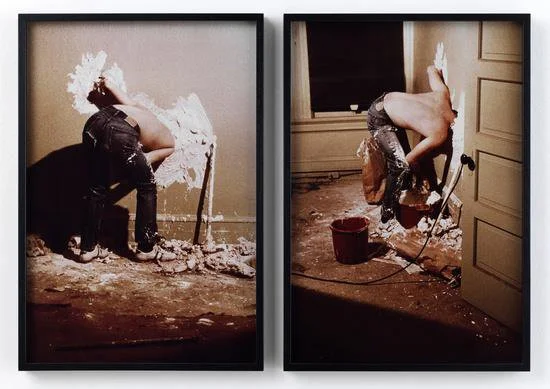AMERICAN INTERIOR
April 27 - June 18, 2017
Richard Artschwager
David Baskin
Lawrence Berzon
Julien Bismuth
Richard Bosman
Barbara Ess
Terence Gower
Dorothea Lange
Louise Lawler
Sherrie Levine
Paul McCarthy
Bill Owens
Gordon Parks
Heidi Schlatter
Claudia Sohrens
Steel Stillman
“The facts we hate, we’ll never meet walking down the road, everybody yelling, ‘Hurry up, hurry up!’ But I’m waiting for you, I must go slow, I must not think bad thoughts. When is this world coming to? Both sides are right, but both sides murder, I give up, why can’t they?”
X, “I Must Not Think Bad Thoughts,” 1983
Upended by the November election results, the American political establishment has been turned on its head. Experiencing a polarizing social and political retrenchment not seen since the Civil War, people scream past each other, dispensing with discourse in favor of heated polemic that matches the rage or vindication that each side feels.
What felt like a shock to many on the coasts may have been motivated by retribution from those in America’s middle, squeezed by the twin challenges of a post-2008 recovery that eluded them and a vanishing demographic identity once referred to as the “middle class.” And yet what both now have in common is the loss of normalcy that the checks and balances of our two-party system was designed to provide.
While the constant upheavals of the new government reflect the instability that brought it into being, it’s worth considering whether its cataclysmic inception in the early hours of last November 9th should have been met with such surprise. The weakening hold with which the established parties have maintained order has been evident in numerous symptoms, though each one was often dismissed as a containable threat to the system as a whole.
Over the last several years, the spate of mass shootings, police violence, and growing homeless population are all reminiscent of the dark, recessionary past of the 1970’s, eventually dispensed with in the public’s imagination by the promise of Ronald Reagan’s “Morning in America.” Reacting to a society that had had enough of “social problems”, our first TV president waved a magic wand and made them go away.
As media increasingly saturates day-to-day life, politics adopts its techniques, shaping reality to suit its goals. While it feels like a bad joke that a reality show entrepreneur now runs the country, it may be an indication that media’s once seamless management of unchecked pathologies inhabiting America’s psyche has reached its limit.
Years of suppressing underlying conflicts sublimated by media’s often-simplified narratives regarding loaded markers such as race and class now seem to be “leaking out.-” As positions harden in the midst of looking for answers, it’s tempting to seek comfort in an interiority that encloses one into known quarters, separate and apart from those presumed to be at fault for our plight.
In examining the American interior as a private, geographic, and psychic space, the interest in this exhibition is to encourage a kind of trespass into realms where our media narratives have failed to tread; an attempt to move forward by looking back at concerns that may have been ignored at our peril.
Installation View
AMERICAN INTERIOR, carriage trade, photo: Nicholas Knight
Installation View
AMERICAN INTERIOR, carriage trade, photo: Nicholas Knight
Installation View
AMERICAN INTERIOR, carriage trade, photo: Nicholas Knight
Installation View
AMERICAN INTERIOR, carriage trade, photo: Nicholas Knight
Installation View
AMERICAN INTERIOR, carriage trade, photo: Nicholas Knight
Installation View
AMERICAN INTERIOR, carriage trade, photo: Nicholas Knight
Installation View
AMERICAN INTERIOR, carriage trade, photo: Nicholas Knight
Richard Artschwager
t,w,m,d,r,b, 2003, etching, 18"x 20" each, Courtesy of Harlan and Weaver
David Baskin
UTICA, 1998-2017, Super 8 film transfer to video format 11" x 14"
Lawrence Berzon
Escapist, 2003, Oil on linen, 22" x 35" (56 x 89 cm)
Julien Bismuth
Top: Untitled (cloaks 4), 2012, Collage, acrylic, 13 3/8" x 13 3/4"
Bottom: Untitled (cloaks 6), 2012, Collage, acrylic, 14 1/4" x 13"
Courtesy of the artist and The Box
Richard Bosman
Civil War Tent, 2005, Oil on canvas, 54" x 60" (137 x 152 cm)
Barbara Ess
No title (snake in living room), 2017, Archival inkjet print, 18" x 24" (46 x 61 cm)
Terence Gower
Kitchen I & II, 2004. Two piezo pigment prints on Hahnemühle photo rag, 22" x 17" (56 x 43 cm) each
Louise Lawler
Tungsten, 2008-2009, Cibachrome, 45 1/4" x 25"
Sherrie Levine
Untitled (President Series), circa 1975, Photograph, 5.5" x 3.5" (14 x 9 cm)
Paul McCarthy
Plaster Your Head and One Arm into a Wall, 1973/2005 Cibachrome photograph, 2 parts,
26 3/8" x 18 1/2" (67 x 47 cm) each, Courtesy of the artist and Hauser and Wirth
Bill Owens
Photo 09, circa 1970s Photograph print, 8" x 10" (20 x 25 cm)



















